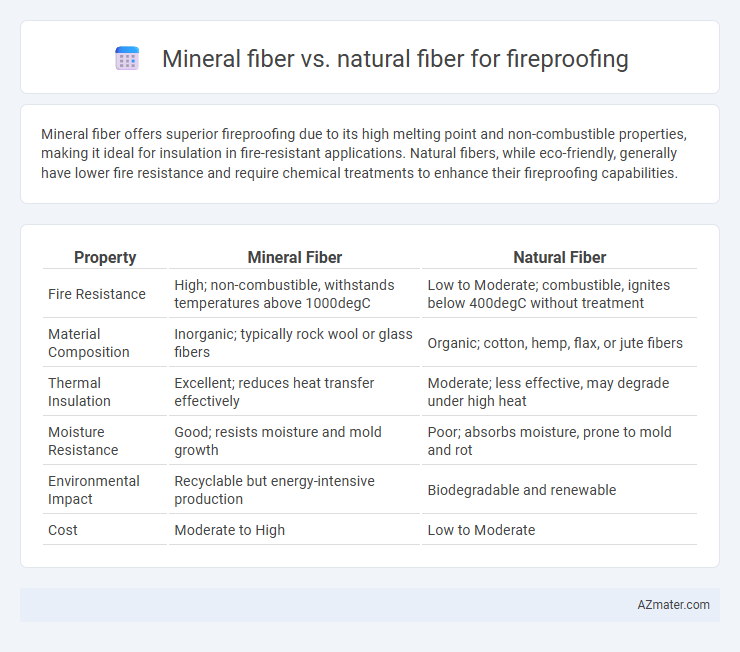Mineral fiber offers superior fireproofing due to its high melting point and non-combustible properties, making it ideal for insulation in fire-resistant applications. Natural fibers, while eco-friendly, generally have lower fire resistance and require chemical treatments to enhance their fireproofing capabilities.
Table of Comparison
| Property | Mineral Fiber | Natural Fiber |
|---|---|---|
| Fire Resistance | High; non-combustible, withstands temperatures above 1000degC | Low to Moderate; combustible, ignites below 400degC without treatment |
| Material Composition | Inorganic; typically rock wool or glass fibers | Organic; cotton, hemp, flax, or jute fibers |
| Thermal Insulation | Excellent; reduces heat transfer effectively | Moderate; less effective, may degrade under high heat |
| Moisture Resistance | Good; resists moisture and mold growth | Poor; absorbs moisture, prone to mold and rot |
| Environmental Impact | Recyclable but energy-intensive production | Biodegradable and renewable |
| Cost | Moderate to High | Low to Moderate |
Introduction to Fireproofing Materials
Mineral fibers such as fiberglass and rock wool are widely preferred in fireproofing due to their non-combustible properties and high melting points, typically above 1000degC, making them effective for thermal insulation and fire resistance. Natural fibers like cotton, hemp, and wool have lower ignition thresholds and often require chemical treatments to enhance fire retardancy, which can affect their environmental benefits. Mineral fiber fireproofing materials offer superior durability and consistent performance in high-temperature environments compared to treated natural fibers.
Overview of Mineral Fibers
Mineral fibers, such as fiberglass and rock wool, are inorganic materials commonly used for fireproofing due to their high melting points and excellent thermal resistance. These fibers provide superior fire resistance compared to natural fibers, which are organic and more combustible, making mineral fibers ideal for applications requiring enhanced fire safety. Their non-combustible nature and ability to withstand temperatures above 1,000degC make mineral fibers a preferred choice in passive fire protection systems.
Overview of Natural Fibers
Natural fibers such as cotton, jute, and hemp are derived from plant sources and offer biodegradability and sustainability in fireproofing applications. Although natural fibers have lower inherent fire resistance compared to mineral fibers like fiberglass or rock wool, treatments with fire retardants can improve their performance. Their lightweight nature and eco-friendly properties make natural fibers a favorable option for environmentally conscious fireproofing solutions.
Fire Resistance Properties: Mineral vs Natural Fibers
Mineral fibers such as fiberglass and rock wool exhibit superior fire resistance properties compared to natural fibers, as they can withstand temperatures exceeding 1000degC without igniting or emitting toxic fumes. Natural fibers like cotton, hemp, or jute are combustible and require chemical treatments to meet fireproofing standards, reducing their environmental benefits. The inherent non-combustibility and thermal stability of mineral fibers make them the preferred choice in fire-resistant insulation and protective materials.
Thermal Insulation Performance
Mineral fiber offers superior thermal insulation performance compared to natural fiber due to its high melting point and low thermal conductivity, making it highly effective in fireproofing applications. Its inorganic composition ensures stability under extreme heat, while natural fibers such as cotton or wool tend to degrade and combust more easily. Mineral wool and fiberglass are common mineral fibers that provide consistent insulation and enhanced fire resistance, essential for building safety and energy efficiency.
Durability and Longevity in Fireproofing
Mineral fibers, such as fiberglass and rock wool, exhibit superior durability and longevity in fireproofing applications due to their inorganic composition, high melting points, and resistance to moisture and chemical degradation. Natural fibers like cotton or hemp, while offering eco-friendly advantages, tend to degrade faster under high temperatures and can absorb moisture, reducing their fire resistance over time. The inherent thermal stability and non-combustible nature of mineral fibers make them the preferred choice for long-lasting fireproofing solutions.
Environmental Impact and Sustainability
Mineral fibers, derived from basalt, slag, or glass, offer superior fireproofing capabilities but have a higher environmental footprint due to energy-intensive manufacturing and mining impacts. Natural fibers like cellulose or hemp provide sustainable alternatives with lower embodied energy, biodegradability, and carbon sequestration benefits but generally have lower fire resistance requiring chemical treatments. Choosing fibers for fireproofing involves balancing mineral fiber durability and fire performance against natural fiber environmental advantages and renewability.
Installation and Maintenance Considerations
Mineral fiber fireproofing offers easier installation due to its rigid form and resistance to sagging, reducing the need for additional support during application. Natural fiber fireproofing requires careful handling to avoid moisture absorption and potential microbial growth, necessitating more frequent inspections and maintenance. Mineral fiber's durability and lower maintenance demands make it a preferred choice for long-term fireproofing performance.
Cost Comparison: Mineral Fiber vs Natural Fiber
Mineral fiber fireproofing materials generally have a higher upfront cost compared to natural fibers due to their advanced manufacturing processes and superior fire resistance properties. However, mineral fibers offer longer durability and lower maintenance expenses, which can reduce overall life-cycle costs. Natural fibers, while initially less expensive, may require more frequent replacement or additional treatment to maintain fireproofing standards, potentially increasing long-term expenditures.
Choosing the Right Fiber for Fireproofing Applications
Mineral fibers, such as fiberglass and rock wool, offer superior fire resistance and thermal insulation compared to natural fibers like cotton or hemp, making them ideal for high-temperature applications. Their non-combustible properties and higher melting points ensure that mineral fibers effectively prevent fire spread and maintain structural integrity under extreme heat. Selecting mineral fibers for fireproofing provides enhanced durability and compliance with stringent fire safety codes in commercial and industrial settings.

Infographic: Mineral fiber vs Natural fiber for Fireproofing
 azmater.com
azmater.com